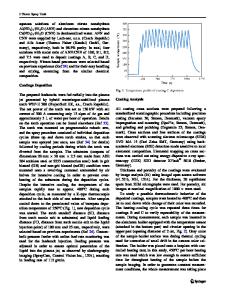Thermodynamic Assessment of Chrome-Spinel Formation in Laser-Sintered Coatings with Cr 2 O 3 Particles
- PDF / 1,611,984 Bytes
- 10 Pages / 593.972 x 792 pts Page_size
- 33 Downloads / 314 Views
I.
INTRODUCTION
HIGH corrosion stability[1] of iron-chromium alloys and chromium steels is explained by the fact that transition into a passive state of such materials is accompanied by the formation of chromium oxides (+3), mixed iron oxides with oxidation degrees +2 and +3, and compact spinel structures with a general composition of FeOÆCr2O3 and Fe2O3ÆCr2O3.[2,3] It should be emphasized that mixed chromium oxides are formed only at a chromium content of at least 12 at. pct in the alloy, while at lower chromium contents the protective properties of surface layers are largely determined by iron oxides.[4] In what follows, the concentration of elements is given in atomic percent unless indicated otherwise. The formation of a protective oxide layer leads to a high corrosion stability of the surface in the Fe-Cr system. Moreover, spontaneous formation of passive oxide layers, containing not only stoichiometric chromium and iron oxides but also chemisorption states of oxides, is observed at contact of Fe-Cr alloys with solutions of electrolytes containing various oxidants, e.g., hydroxide ions in water or oxide ions in glasses and
SERGEY RESHETNIKOV, Full Professor, is with the Institute of Natural Sciences, Udmurt State University, Universitetskaya str. 1, 426034 Izhevsk, Russia. MIKHAIL KRIVILYOV and EVGENY KHARANZHEVSKIY, Associate Professors, are with the Institute of Mathematics, Informatics and Physics, Udmurt State University. Contact e-mail: [email protected] LESLEY J. BEYERS, Ph.D. Candidate, is with the Department of Materials Engineering, KU Leuven, Kasteelpark Arenberg 44, 3001 Leuven, Belgium. Manuscript submitted August 18, 2015. Article published online February 26, 2016. METALLURGICAL AND MATERIALS TRANSACTIONS B
slags. Transition into a passive state with formation of oxide layers is also facilitated by anodic polarization of alloys in electrolytes.[5] Protective coatings based on Cr2O3 improve the corrosion resistance of low-alloy steels and can be formed using electrophoretic deposition, magnetron sputtering, plasma spraying, laser sintering, and atomic layer deposition.[6] Laser sintering of composite powders led to development of a wide class of processing SLS and SLM methods[7] to design bulk complex-shaped materials and also functional coatings, such as Cr2O3 thin films deposited on Si and glass substrates by pulsed laser deposition.[8] From among these methods, Kharanzhevskiy et al.[9] recently suggested a new technique that can provide formation of chromium oxide solid solutions and thin chromium oxide surface films. The technique is based on direct short pulse laser processing of ultrafine chromium oxide powder predeposited on the surface of a sample. In our previous work devoted to high-speed laser sintering of high dispersive powders,[10–12] it was found that high heating and cooling rates lead to rapid solidification in strong non-equilibrium conditions, accompanied by metastable phase formation. In this context, the objective of this paper is to provide theoretical assessment and explain the forma
Data Loading...










